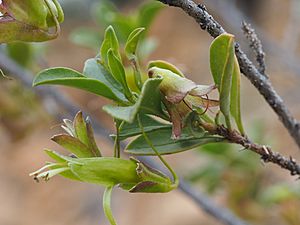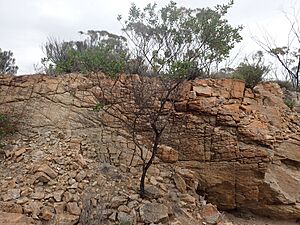Humped fuchsia bush facts for kids
Quick facts for kids Humped fuchsia bush |
|
|---|---|
 |
|
| Eremophila gibbosa leaves and flowers | |
| Scientific classification | |
| Genus: |
Eremophila (plant)
|
| Species: |
gibbosa
|
The Eremophila gibbosa, also known as the humped fuchsia bush, is a special flowering plant. It belongs to the figwort family, called Scrophulariaceae. This plant is only found in Western Australia, making it endemic to that area. It's a shrub with shiny, sticky leaves and yellowish-green flowers. Often, it grows in large, dense groups.
Contents
What Does the Humped Fuchsia Bush Look Like?
The humped fuchsia bush is a shrub that can grow from about 0.5 to 3.5 meters (1.6 to 11.5 feet) tall. It has many shiny branches that stand upright. This plant can also send out new shoots from its base, which sometimes creates thick, bushy areas. Its leaves grow one after another along the stem. They are shaped like an oval or an egg, usually 15-35 mm (0.6-1.4 inches) long and 7-18 mm (0.3-0.7 inches) wide. Each leaf has a short stem about 4-8 mm (0.16-0.31 inches) long.
Flowers and Fruits
The flowers grow one by one where the leaves meet the stem. Each flower sits on a sticky, S-shaped stalk that is 10-15 mm (0.4-0.6 inches) long. There are 5 green or purple sepals (leaf-like parts that protect the flower bud). These are usually 6.5-12 mm (0.26-0.47 inches) long and smooth, except for a bunch of white hairs near their tips.
The petals are 20-30 mm (0.8-1.2 inches) long and are joined at the bottom to form a tube. This tube is yellowish-green and covered with tiny sticky hairs both inside and out. The 4 stamens (the parts that produce pollen) stick out beyond the end of the tube. The humped fuchsia bush flowers from May to September. After flowering, it produces dry, woody fruits. These fruits are almost round with a pointed tip and are about 3-4 mm (0.12-0.16 inches) wide.

How the Humped Fuchsia Bush Got Its Name
The humped fuchsia bush, Eremophila gibbosa, was first officially described in 1979. This was done by a scientist named Robert Chinnock. He published his description in a scientific paper called Journal of the Adelaide Botanic Garden.
The second part of its scientific name, gibbosa, comes from a Latin word. It means "humpbacked," "humped," "crooked," or "bent." This name refers to the interesting shape of the fruits of this plant.
Where the Humped Fuchsia Bush Grows
This type of eremophila plant often grows in clay soil, especially in areas that have been disturbed. This includes places that have been affected by fires. You can find it growing between the towns of Balladonia and Lake Johnston in the Coolgardie area of Western Australia.
Is the Humped Fuchsia Bush Endangered?
The humped fuchsia bush is currently not considered to be in danger. The Western Australian Government's Department of Parks and Wildlife has classified it as "not threatened." This means there are enough of these plants in the wild for now.
Growing the Humped Fuchsia Bush in Gardens
The unique leaves of the humped fuchsia bush are very attractive, as are its small blue to purple flowers. This plant is a good choice for a small garden or for growing in a pot.
Planting Tips
You can grow new plants from cuttings (small pieces of the plant). However, it might grow even better if it is grafted onto a Myoporum rootstock. Grafting means joining a part of one plant to the root system of another. A grafted plant can grow well in most types of soil. This shrub can handle dry weather and frost. But it will be healthier if you water it sometimes during very dry periods.

